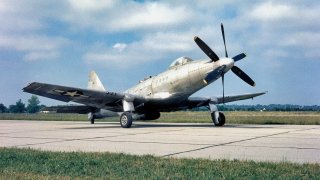XP-75 Eagle: The ‘Frankenplane’ That Failed to Take Flight
The Fisher XP-75/P-75A Eagle, nicknamed the "Frankenplane," was designed during World War II by combining parts from existing aircraft like the P-51 Mustang, SBD Dauntless, and F4U Corsair.
Summary and Key Points: The Fisher XP-75/P-75A Eagle, nicknamed the "Frankenplane," was designed during World War II by combining parts from existing aircraft like the P-51 Mustang, SBD Dauntless, and F4U Corsair.
-It featured a powerful Allison V-3420 engine, ten .50 caliber machine guns, and a max speed of 430 mph.
-Despite high expectations, the plane was a failure due to design flaws, poor management, and high costs. Only 14 were built, and the project was terminated in 1944.
-One surviving XP-75 is displayed at the National Museum of the United States Air Force, restored after extensive deterioration.
XP-75 Eagle: How the ‘Frankenplane’ Became a WWII Failure
The concept of Frankenstein became so ingrained in pop culture that the word came to be contextually used to mean – as per Urban Dictionary – “Taking bits and pieces of old projects, putting them together and making a new project.” Hence the concept behind the “Frankenplane” aka the “Wonderplane,” i.e. the XP-75/P-75A Eagle.
Fisher XP-74/P-75A Eagle Early History and Specifications
The XP-75 Eagle made her maiden flight on November 17, 1943. She was built by the now-defunct Fisher Body Division of General Motors. As noted by YouTube video “The ‘Wonderplane’ Slapped Together With Spare Parts: Fisher XP-75 Eagle,” the driving motivational factor behind the design of the plane was the U.S. Army Air Force’s desire for “something better, something that would outclass whatever enemy Fighters it could come across; something with high max speed, a high rate of climb and good operating range.”
On paper, the Eagle’s desirability was bolstered by accommodating the most powerful inline engine available at the time, the Allison V-3420. The “Frankenplane’s” nickname stemmed from the fact that the original design concept used components from three different warbirds already in production: the wings would be pulled from the North American P-51 Mustang fighter plane; the tail and entire empennage – an arrangement of stabilizing surfaces at the tail of an aircraft – would be pulled from the Douglas SBD Dauntless dive bomber and the landing gear would be pulled from the Vought F4U Corsair fighter.
Specifications included a crew of one, a fuselage length of 40 feet 5 inches, a wingspan of 49 feet 4 inches, a height of 15 feet 6 inches, an empty weight of 11,495 pounds, and a gross weight of 19,420 pounds. Max airspeed was 430 miles per hour, with an operational range of 2,600 nautical miles and a service ceiling of 36,400 feet. Armament consisted of a whopping ten .50 caliber machine guns, with six mounted in the wings and four in the fuselage. For a sense of perspective, America’s most heavily armed fighter plane in terms of the number of guns that actually served in combat, the Republic P-47 Thunderbolt, packed a mere eight such .50 cals. The “Frankenplane” could also carry two 500-lb, bombs for good measure.
Performance (or Lack Thereof)
Would a “Wonderplane” mashed together from those three other warplanes – all of which turned out to be legendary performers in actual combat – would turn out to be a legend in her own right? Er, not so much. Some aviation historians have even gone so far as to deem the P-75 Eagle a “turkey” and even the worst military airplane ever.
As Stephan Wilkinson of HistoryNet put it bluntly back in September 2020:
“The Fisher XP-75 Eagle was the worst aircraft that U.S. taxpayers bought during World War II. When the P-75 program was finally shut down in October 1944, only 14 unarmed, useless aircraft had been manufactured. Estimates vary wildly as to how much each airplane cost, but the kindest guess is about $9,375,000 in 2020 dollars. (The Republic P-47 Thunderbolt, which the P-75 was intended to replace, went for roughly $1.2 million in today’s dollars.) How could this have happened? Blame it on stupidity, greed, poor management, an unfortunate engine choice and an overrated aircraft designer.”
The YouTube video is a wee bit kinder in an assessment of the plane: “I don't personally think the XP-75 deserves the title of worst military plane ever – I do understand that perspective – but I would rather call it one of the most mismanaged planes of World War II.”
No matter how you slice the proverbial pie, however, the “Frankenplane” was a failure.
Where Are They Now?
Out of those 14 “useless” XP-75s and P-75As built – eight of the former and six of the latter – there is a sole survivor: Serial No. 44-44553, housed at the Experimental Aircraft Gallery of National Museum of the United States Air Force at Wright-Patterson AFB near Dayton, Ohio. This specimen had to undergo a major restoration project starting back in 1999 after extensive deterioration was noticed. Thankfully the project (unlike the plane itself) succeeded.
About the Author
Christian D. Orr is a prominent defense writer with over 800 published articles. He is a former Air Force Security Forces officer, Federal law enforcement officer, and private military contractor (with assignments worked in Iraq, the United Arab Emirates, Kosovo, Japan, Germany, and the Pentagon). Chris holds a B.A. in International Relations from the University of Southern California (USC) and an M.A. in Intelligence Studies (concentration in Terrorism Studies) from American Military University (AMU). He has also been published in The Daily Torch and The Journal of Intelligence and Cyber Security. Last but not least, he is a Companion of the Order of the Naval Order of the United States (NOUS).
Imave Credit: Creative Commons.


